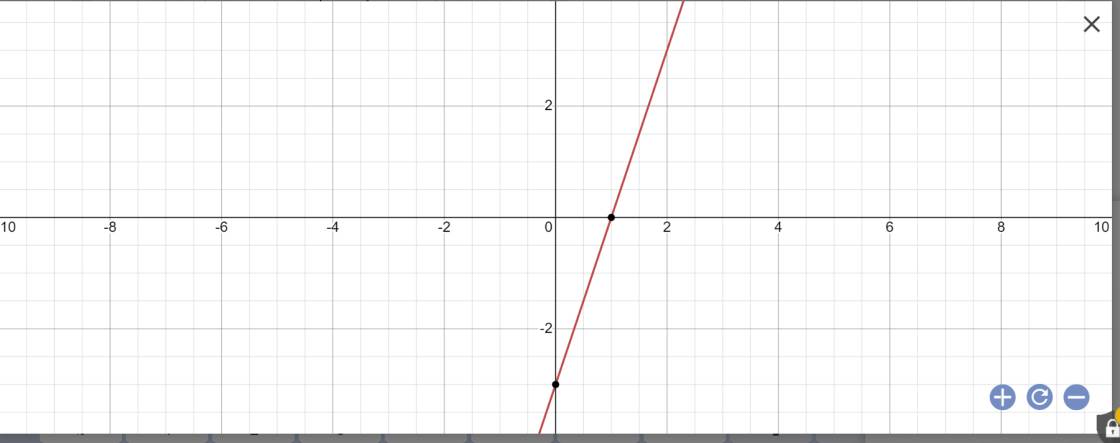Hãy nhập câu hỏi của bạn vào đây, nếu là tài khoản VIP, bạn sẽ được ưu tiên trả lời.

Mình quên mất. Đng học lp 8 nhưng học trc chương trình nên quên sửa lớp luôn

Lời giải:
a. Để hs trên là hàm bậc nhất thì:
$4m2-4m+1\neq 0$
$\Leftrightarrow (2m-1)^2\neq 0$
$\Leftrightarrow 2m-1\neq 0$
$\Leftrightarrow m\neq \frac{1}{2}$
b.
$f(1)=(4m^2-4m+1).1-3=4m^2-4m-2=6$
$\Leftrightarrow 4m^2-4m-8=0$
$\Leftrightarrow m^2-m-2=0$
$\Leftrightarrow (m+1)(m-2)=0$
$\Leftrightarrow m=-1$ hoặc $m=2$

Câu 5:
a: Khi m=3 thì \(f\left(x\right)=\left(2\cdot3+1\right)x-3=7x-3\)
\(f\left(-3\right)=7\cdot\left(-3\right)-3=-21-3=-24\)
\(f\left(0\right)=7\cdot0-3=-3\)
b: Thay x=2 và y=3 vào f(x)=(2m+1)x-3, ta được:
\(2\left(2m+1\right)-3=3\)
=>2(2m+1)=6
=>2m+1=3
=>2m=2
=>m=1
c: Thay m=1 vào hàm số, ta được:
\(y=\left(2\cdot1+1\right)x-3=3x-3\)
*Vẽ đồ thị

d: Để hàm số y=(2m+1)x-3 là hàm số bậc nhất thì \(2m+1\ne0\)
=>\(2m\ne-1\)
=>\(m\ne-\dfrac{1}{2}\)
e: Để đồ thị hàm số y=(2m+1)x-3 song song với đường thẳng y=5x+1 thì \(\left\{{}\begin{matrix}2m+1=5\\-3\ne1\end{matrix}\right.\)
=>2m+1=5
=>2m=4
=>m=2

a: Để hàm số y=(m-2)x+m+3 nghịch biến trên R thì m-2<0
=>m<2
b: Thay x=3 và y=0 vào y=(m-2)x+m+3, ta được:
\(3\left(m-2\right)+m+3=0\)
=>3m-6+m+3=0
=>4m-3=0
=>4m=3
=>\(m=\dfrac{3}{4}\)
c: Tọa độ giao điểm của hai đường thẳng y=-x+2 và y=2x-1 là:
\(\left\{{}\begin{matrix}2x-1=-x+2\\y=-x+2\end{matrix}\right.\)
=>\(\left\{{}\begin{matrix}3x=3\\y=-x+1\end{matrix}\right.\Leftrightarrow\left\{{}\begin{matrix}x=1\\y=-1+1=0\end{matrix}\right.\)
Thay x=1 và y=0 vào y=(m-2)x+m+3, ta được:
\(1\left(m-2\right)+m+3=0\)
=>m-2+m+3=0
=>2m+1=0
=>2m=-1
=>\(m=-\dfrac{1}{2}\)

Ta có \(y'=\frac{x^2-2mx+m^2}{\left(x-2m\right)^2},x\ne2m\)
Để y có hai khoảng đồng biến trên toàn miền xác định thì
\(y'\ge0,\forall x\ne2m\)
\(\Leftrightarrow x^2-4mx+m^2\ge0,\forall x\ne2m\)
\(\Leftrightarrow\Delta'\le0\Leftrightarrow4m^2-m^2\le0\)
\(\Leftrightarrow3m^2\le0\Leftrightarrow m=0\)
Câu tiếp theo:
y đồng biến trên\(\left(1,\infty\right)\Leftrightarrow y'\ge0,\forall x\in\left(1,+\infty\right)\)
\(\Leftrightarrow\hept{\begin{cases}f\left(x\right)=x^2-4mx+m^2\ge0,\forall x>1\\2m\notin\left(1,\infty\right)\end{cases}}\)
Để cj suy nghĩ mai lm tiếp=.=
rõ ràng m=0 thì đk trên thõa mãn.
Với \(m=0:\Delta'=3m^2>0\) nên ta có:
\(f\left(x\right)\ge0,\forall x>1\Leftrightarrow x_1< x_2\le1\)
\(\Leftrightarrow\hept{\begin{cases}\Delta'>0\\f\left(1\right)\ge\\\frac{S}{2}-1< 0\end{cases}0}\)
\(f\left(1\right)\ge0\Leftrightarrow m^2-4m+1\ge0\Leftrightarrow m\le2-\sqrt{3}\)hay\(m\ge2+\sqrt{3}\)
\(\frac{S}{2}-1< 0\Leftrightarrow2m-1< 0\Leftrightarrow m< \frac{1}{2}\)
\(2m\notin\left(1,\infty\right)\Leftrightarrow2m\le1\Leftrightarrow m\le\frac{1}{2}\)
Vậy \(m\le2-\sqrt{3}\)là giá trị m cần tìm
Ta có: \(y'=a\)\(cosx-b\)\(sinx+1\)
y đồng biến trên R \(\Leftrightarrow y'\ge0,\forall x\in R\)
\(\Leftrightarrow acosx-bsinx+1\ge0,\forall x\in R\)(*)
Theo bất đẳng thức Schwartz thì:
\(|acosx-bsinx|\le\sqrt{a^2+b^2},\forall x\)
\(\Leftrightarrow-\sqrt{a^2+b^2}\le acos-bsinx\le\sqrt{a^2+b^2},\forall x\)
\(\Leftrightarrow1-\sqrt{a^2+b^2}\le acos-bsinx+1\le1+\sqrt{a^2+b^2},\forall x\)
Do đó (*) \(\Leftrightarrow1-\sqrt{a^2+b^2}\ge0\)
\(\Leftrightarrow\sqrt{a^2+b^2}\le1\)
\(\Leftrightarrow a^2+b^2\le1\)